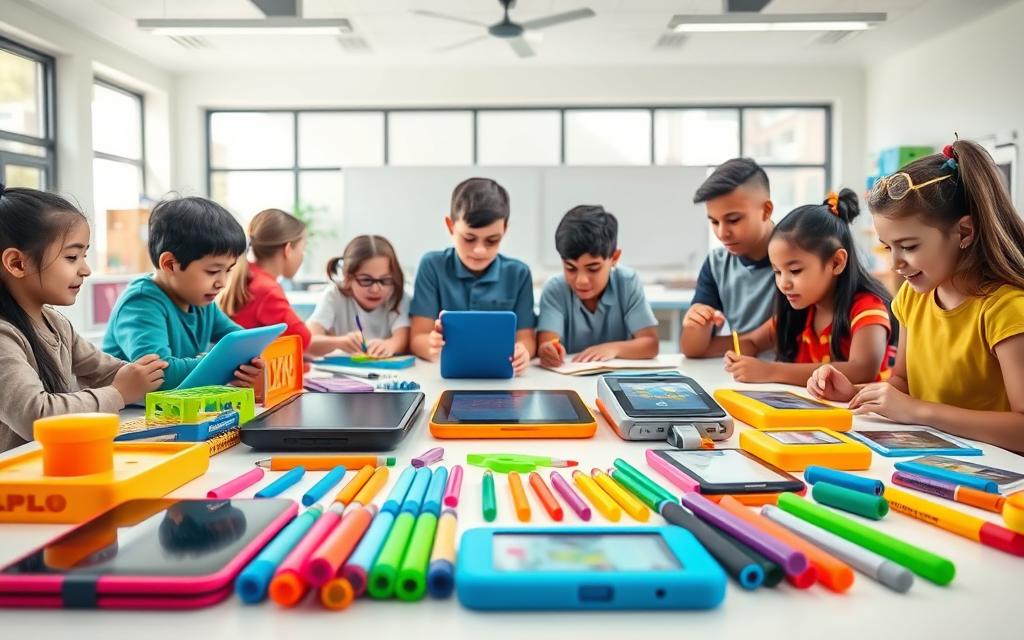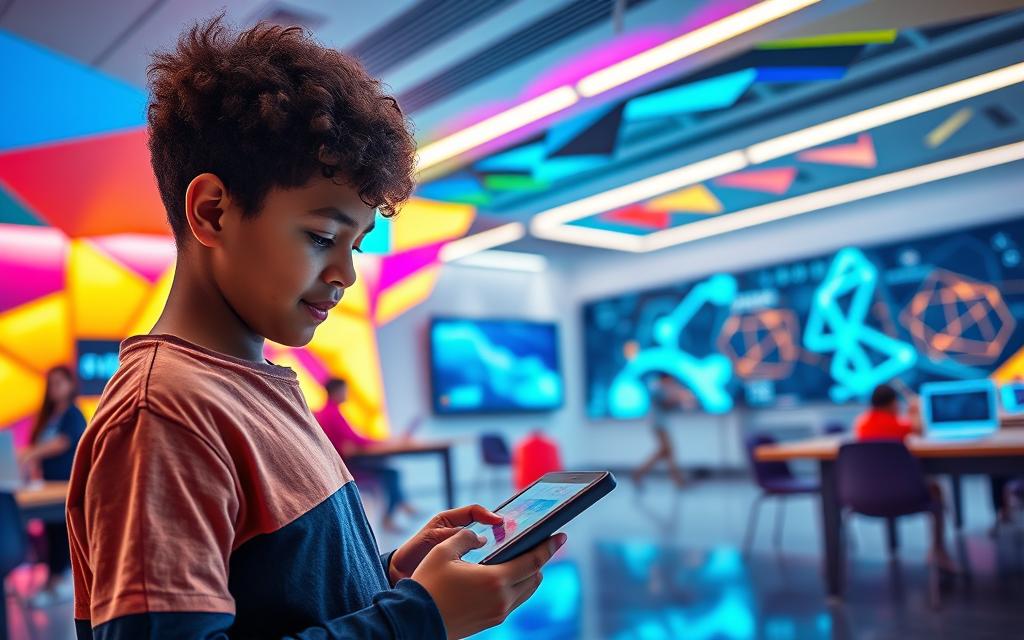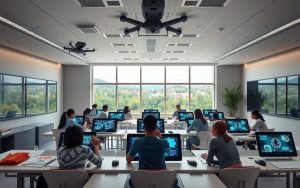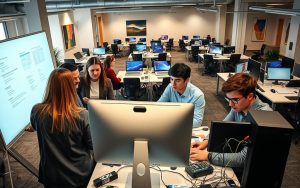Imagine a 14th-century classroom with parchment scrolls and wax tablets. Just one teacher spoke to rows of students. This scene, from Purdue University’s archives, shows education’s old challenges: limited resources and unequal access. Now, digital learning tools have changed these problems, offering new chances.
The move from quills to touchscreens is more than just easier. Modern educational growth strategies use artificial intelligence and cloud platforms. They let students learn in their own way. Unlike medieval times, today’s students work together online, using data and simulations.
This change is not just about new tech. It’s a big shift in how we learn. Online resources share knowledge widely, and software finds where students need help. The use of technology in education connects past and present, offering new ways to learn.
Looking at these changes, we see one thing clearly: digital tools haven’t made us less curious. They’ve made us more. With tools like virtual reality and AI tutors, today’s learners can grow in new ways. This shows how important innovation is for the future.
The Digital Transformation of Education
Classrooms have changed a lot. They now use digital tools instead of old-fashioned desks. This change is not just about using screens. It’s a big shift in how we learn and teach.
From Chalkboards to Cloud-Based Systems
The journey started with small changes:
- 1990s: First virtual learning environments (VLEs) emerged
- 2004: Interactive whiteboards became common in classrooms
- 2012: Cloud storage became affordable for schools
- 2020: The pandemic made hybrid systems more popular
Historical Milestones in Educational Technology
Early digital tools were just copies of old methods. Now, cloud-based education lets students work together from anywhere. Stanford researchers warn: “The ESSER funding cliff could reverse progress, with 68% of districts worried about sustainability.”
- 94% of universities use cloud-based learning management systems
- K-12 cloud adoption jumped from 42% to 81% since 2019
- 32 states now require digital literacy in core curricula
Shifting Paradigms in Teaching Methodologies
Old teaching methods are being replaced by new, interactive ones. Purdue University’s 2023 study found teachers now spend 60% less time lecturing than before.
Flipped Classroom Models
This method flips the traditional homework/lecture order. Students watch videos at home and then apply what they learned in class through:
- Group problem-solving sessions
- Interactive simulations
- Peer-to-peer teaching activities
Competency-Based Progression Systems
Students move forward when they master skills, not just by time. Early users report:
- 23% higher retention rates
- 41% reduction in achievement gaps
- Customisable pacing for neurodiverse learners
How Technology Enhances Learning Experiences
Modern education has moved beyond old textbooks. Digital tools create immersive learning environments for all. They don’t just share information; they change how we learn, interact, and remember through personal experiences.
Interactive Learning Through Multimedia Content
Today’s platforms mimic real-life scenarios with amazing detail. Labster’s virtual lab simulations let chemistry students do explosive experiments safely. Medical students can explore 3D models of organs, getting insights that real bodies can’t offer.

Technology now checks our learning instantly. Systems like automated essay scoring and IXL Learning adjust maths problems based on how well we do. As research shows, this quick feedback helps us fix mistakes before they become bad habits.
Gamification of Educational Content
Duolingo and Minecraft show how fun can make learning stick. Archbishop Williams High School saw a 97% increase in student participation with gamified learning. A teacher noted:
“Students who found worksheets hard now dive into programming challenges with excitement. They learn to keep going through digital rewards.”
This change is key: learning is now about gaining skills, not just knowing facts. Adaptive learning platforms tailor lessons to fit each student’s needs. This makes even tough subjects like STEM seem reachable.
Democratising Access to Educational Resources
Once, learning was a rare privilege, hidden away in monasteries. Now, digital resources flow freely worldwide. This change has made education a basic right, thanks to three key innovations.
Mobile Learning Platforms
Coursera’s global classroom initiatives have opened doors for 129 million learners. They can access top university courses through smartphone apps. This shows how mobile learning solutions can cross borders.
Khan Academy’s free curriculum resources help 18 million users each month. They offer short video lessons that match US education standards.
Video Conferencing Solutions
Today’s virtual classrooms do more than just video calls. Zoom offers special features for education:
| Feature | Zoom for Education | Consumer Version |
|---|---|---|
| Breakout Rooms | Unlimited duration | 40-minute limit |
| Cloud Recording | 1GB per licence | 500MB |
| SSL Encryption | FIPS 140-2 compliant | Standard |
Microsoft Teams makes teamwork better with tools like OneNote Class Notebooks. It’s used by 70% of US universities.
Open Educational Resources (OER)
MIT OpenCourseWare has reached 225 countries, offering 2,500+ courses. Purdue University’s online MSEd programme shows how OER can lead to professional growth. It uses open-source materials for accredited certification.
“Open education resources could save US students $1.3 billion annually in textbook costs.”
Personalised Learning Through Adaptive Technologies
Imagine classrooms where lessons fit each student’s strengths, not the other way around. Adaptive technologies are making this dream come true. They use data to create learning paths just for each student.
These tools don’t just respond to learners; they anticipate their needs. They fill gaps before they get too big.

AI-Powered Learning Analytics
Platforms like Carnegie Learning’s MATHia use machine learning to understand how students solve problems. It changes maths exercises to match each student’s progress. This helps avoid frustration by offering challenges that are just right.
Knewton’s adaptive courseware also customises learning based on how well students do. This approach is backed by Stanford’s CRAFT programme. It focuses on using AI in a way that respects student choices and control.
Customised Learning Pathways
Smart Sparrow’s adaptive e-learning lets teachers create different learning paths. A student struggling with cell division might get 3D models, while others move on to genetics. This way, everyone learns at their own pace.
For younger students, DreamBox Learning turns maths into exciting quests. Each correct answer opens up new challenges in a story.
Accessibility Features for Diverse Needs
Tools like Read&Write help students with dyslexia by reading text aloud and predicting words. Microsoft’s Immersive Reader goes further with syllable breakdowns and picture dictionaries. This is a big step up from old SEN resources.
As one teacher said, these tools are more than just help. They empower students, making learning fair for everyone.
Addressing Challenges in Tech-Enabled Education
Technology is changing how we learn, but big challenges need quick fixes. We must tackle three main issues: unequal access, data safety, and the need for personal connections. Policymakers and teachers must work together to solve these problems.
Bridging the Digital Divide
There are different ways to tackle the digital divide:
One Laptop per Child Initiatives
OLPC gives each child a laptop. But, keeping them working is hard. A 2023 study found that 38% of laptops in poor countries stopped working in 18 months.
Public Library Technology Schemes
Libraries offer free Wi-Fi and shared computers. This helps 12 million Americans each month. It’s cheaper but doesn’t help with homework at night.
| Initiative | Coverage | Success Rate | Key Limitation |
|---|---|---|---|
| OLPC Programmes | Device ownership | 62% operational after 1 year | Technical support gaps |
| Library Hotspots | Community access | 89% weekly utilisation | Restricted operating hours |
Data Privacy Concerns
K-12 cyberattacks have risen 214% since 2020. We need strong rules to protect data:
COPPA Compliance in EdTech Tools
The Children’s Online Privacy Protection Act requires parents’ consent for kids’ data. But, 41% of apps don’t follow this rule, according to the FTC.
GDPR Implications for Learning Platforms
European rules affect global platforms. Schools see 57% fewer data breaches with GDPR-compliant systems.
Maintaining Human Connections
The UNESCO 2023 Technology in Education Report talks about using tech wisely. It keeps the focus on people:
Balancing Screen Time in Primary Education
A 2021 study by NSSE found too much tech can make kids anxious. Kids with more than 4 hours of tech a day were 23% more anxious than others.
Teacher Training Programmes for Tech Integration
In California, teachers got better at using tech in class. This cut down on tech problems in class by 68%.
Conclusion
The way we learn is changing fast. Places like Stanford University are leading the way with new teaching methods. They use technology to make learning more personal and interactive.
David Schwartz’s work shows the good and bad sides of using AI in education. It can make learning fit each person’s needs. But, teachers must keep data safe and make sure everyone has access.
It’s important to keep learning throughout our lives. Programs like Purdue University’s MSEd help teachers use technology wisely. By focusing on both tech and teaching, we can improve education for everyone.







